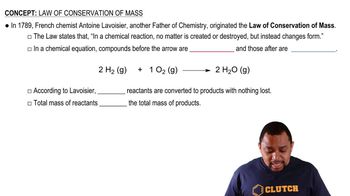Here are the essential concepts you must grasp in order to answer the question correctly.
Nuclear Reactions
Nuclear reactions involve changes in an atom's nucleus and can result in the transformation of one element into another. These reactions can be classified into types such as fusion, fission, and radioactive decay, each with distinct processes and products. Understanding the type of nuclear reaction is crucial for predicting the resulting elements and isotopes.
Recommended video:
Conservation of Mass and Charge
In nuclear reactions, both mass and charge must be conserved. This means that the total mass number (the sum of protons and neutrons) and the total charge before and after the reaction must remain equal. This principle helps in balancing nuclear equations and determining the products of the reaction.
Recommended video:
Law of Conservation of Mass
Types of Particles
Nuclear reactions often involve the emission or absorption of various particles, such as alpha particles (helium nuclei), beta particles (electrons or positrons), and gamma rays (high-energy photons). Recognizing these particles is essential for identifying the products of a nuclear reaction, as they influence the resulting isotopes and energy changes.
Recommended video:
 Verified step by step guidance
Verified step by step guidance


